P&G: Culture, Power, Motivation & Organisation Behaviour Analysis
VerifiedAdded on 2023/06/12
|17
|5492
|405
Report
AI Summary
This report provides an analysis of organisation behaviour within the context of Procter & Gamble (P&G), focusing on the influence of organisational culture, power structures, and workplace politics on individual and team performance. It evaluates context and process theories of motivation, such as Maslow's hierarchy of needs and Herzberg's two-factor theory, and explores techniques for achieving organisational goals. The report differentiates between effective and ineffective teams and applies concepts like Handy's model of culture, Hofstede's cultural dimensions, and network and systems theories to understand and influence behaviour within the organisation, highlighting the importance of cultural difference awareness and strategies for fostering a positive and productive work environment.
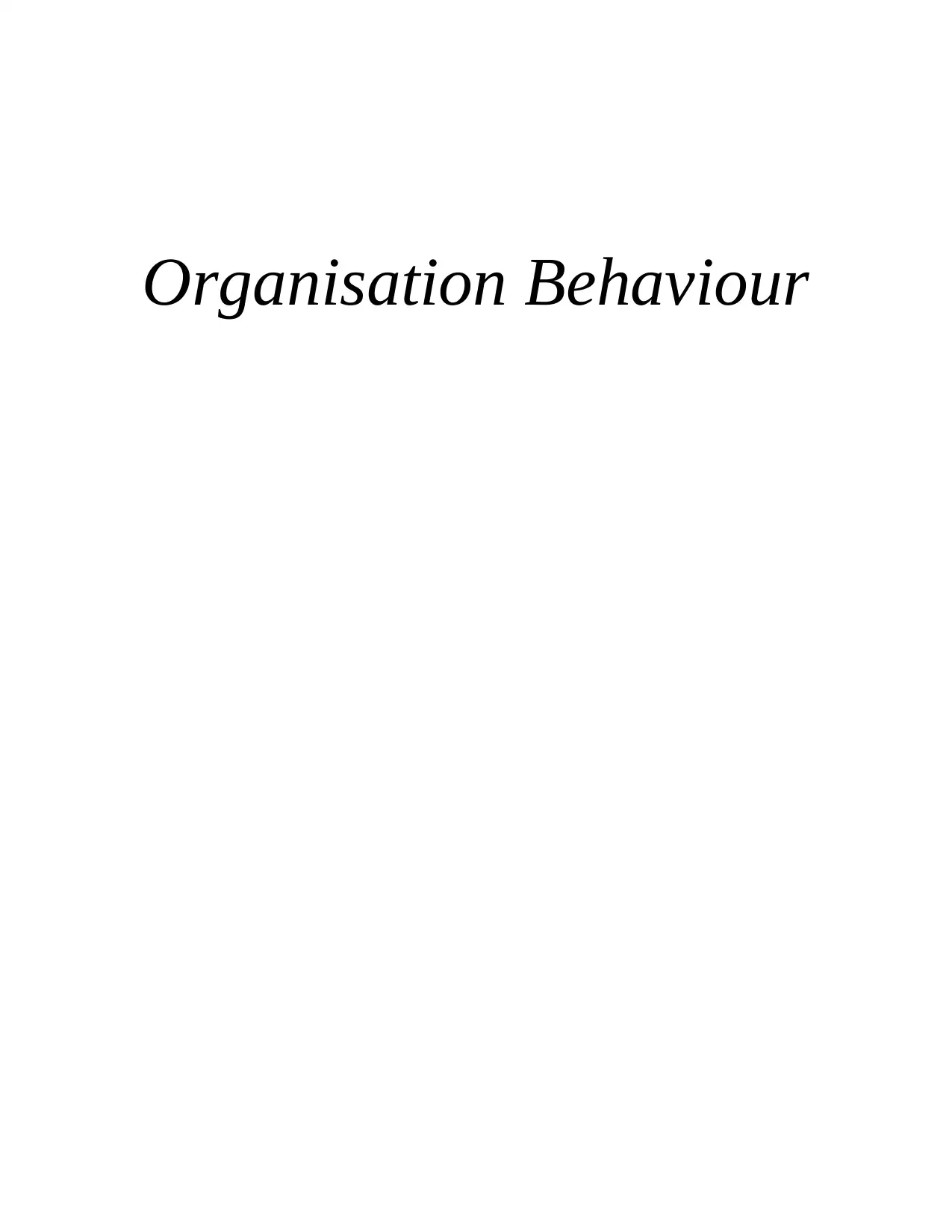
Organisation Behaviour
Paraphrase This Document
Need a fresh take? Get an instant paraphrase of this document with our AI Paraphraser
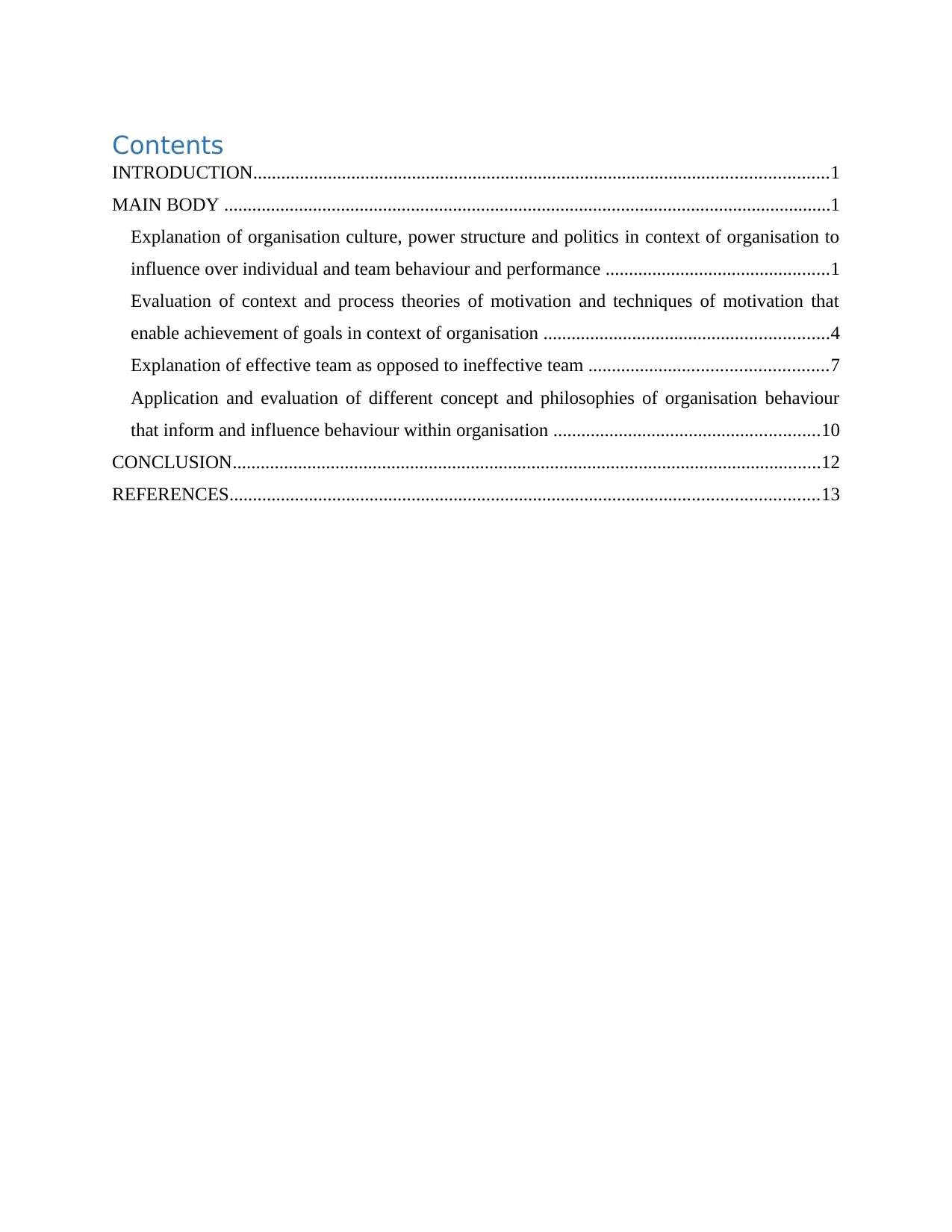
Contents
INTRODUCTION...........................................................................................................................1
MAIN BODY ..................................................................................................................................1
Explanation of organisation culture, power structure and politics in context of organisation to
influence over individual and team behaviour and performance ................................................1
Evaluation of context and process theories of motivation and techniques of motivation that
enable achievement of goals in context of organisation .............................................................4
Explanation of effective team as opposed to ineffective team ...................................................7
Application and evaluation of different concept and philosophies of organisation behaviour
that inform and influence behaviour within organisation .........................................................10
CONCLUSION..............................................................................................................................12
REFERENCES..............................................................................................................................13
INTRODUCTION...........................................................................................................................1
MAIN BODY ..................................................................................................................................1
Explanation of organisation culture, power structure and politics in context of organisation to
influence over individual and team behaviour and performance ................................................1
Evaluation of context and process theories of motivation and techniques of motivation that
enable achievement of goals in context of organisation .............................................................4
Explanation of effective team as opposed to ineffective team ...................................................7
Application and evaluation of different concept and philosophies of organisation behaviour
that inform and influence behaviour within organisation .........................................................10
CONCLUSION..............................................................................................................................12
REFERENCES..............................................................................................................................13

⊘ This is a preview!⊘
Do you want full access?
Subscribe today to unlock all pages.

Trusted by 1+ million students worldwide
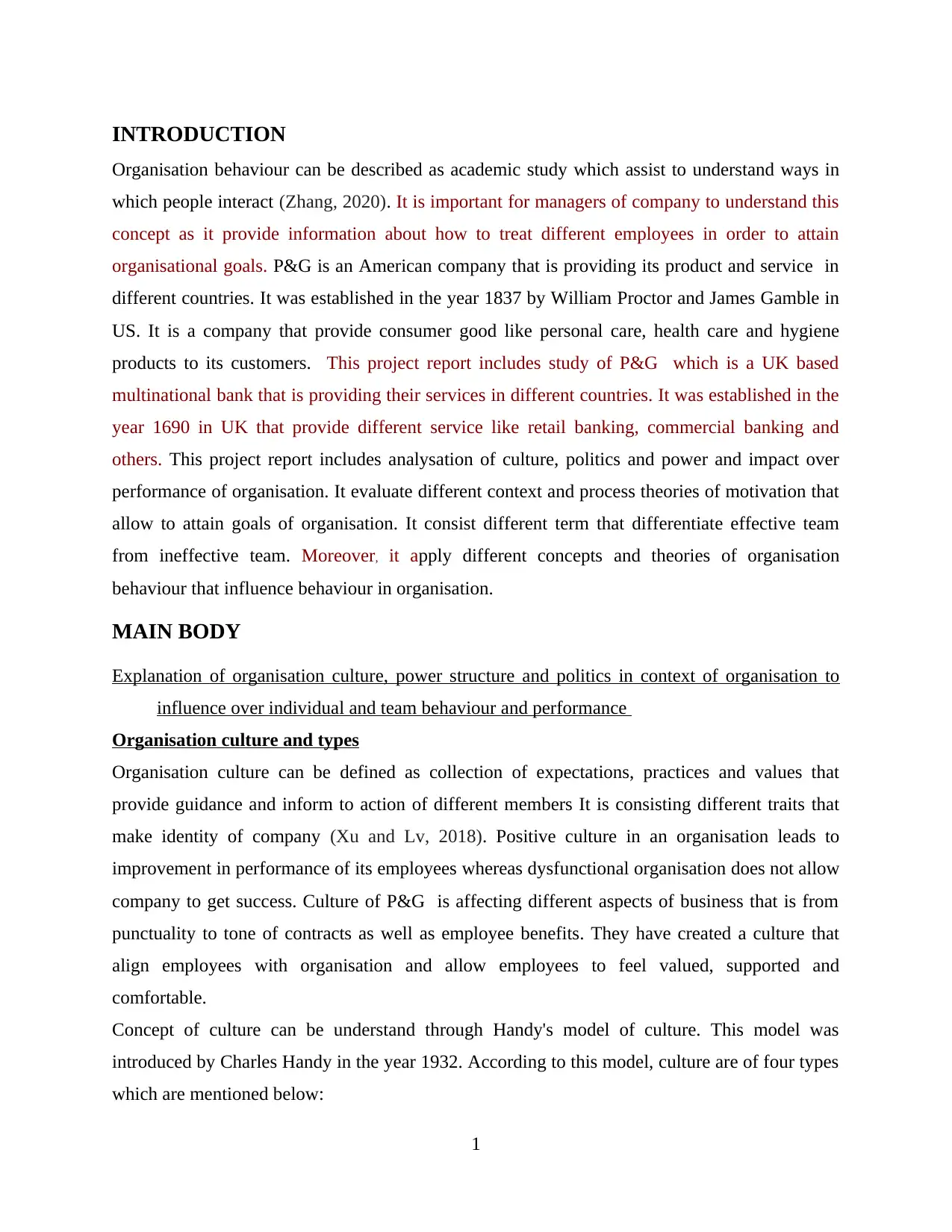
INTRODUCTION
Organisation behaviour can be described as academic study which assist to understand ways in
which people interact (Zhang, 2020). It is important for managers of company to understand this
concept as it provide information about how to treat different employees in order to attain
organisational goals. P&G is an American company that is providing its product and service in
different countries. It was established in the year 1837 by William Proctor and James Gamble in
US. It is a company that provide consumer good like personal care, health care and hygiene
products to its customers. This project report includes study of P&G which is a UK based
multinational bank that is providing their services in different countries. It was established in the
year 1690 in UK that provide different service like retail banking, commercial banking and
others. This project report includes analysation of culture, politics and power and impact over
performance of organisation. It evaluate different context and process theories of motivation that
allow to attain goals of organisation. It consist different term that differentiate effective team
from ineffective team. Moreover, it apply different concepts and theories of organisation
behaviour that influence behaviour in organisation.
MAIN BODY
Explanation of organisation culture, power structure and politics in context of organisation to
influence over individual and team behaviour and performance
Organisation culture and types
Organisation culture can be defined as collection of expectations, practices and values that
provide guidance and inform to action of different members It is consisting different traits that
make identity of company (Xu and Lv, 2018). Positive culture in an organisation leads to
improvement in performance of its employees whereas dysfunctional organisation does not allow
company to get success. Culture of P&G is affecting different aspects of business that is from
punctuality to tone of contracts as well as employee benefits. They have created a culture that
align employees with organisation and allow employees to feel valued, supported and
comfortable.
Concept of culture can be understand through Handy's model of culture. This model was
introduced by Charles Handy in the year 1932. According to this model, culture are of four types
which are mentioned below:
1
Organisation behaviour can be described as academic study which assist to understand ways in
which people interact (Zhang, 2020). It is important for managers of company to understand this
concept as it provide information about how to treat different employees in order to attain
organisational goals. P&G is an American company that is providing its product and service in
different countries. It was established in the year 1837 by William Proctor and James Gamble in
US. It is a company that provide consumer good like personal care, health care and hygiene
products to its customers. This project report includes study of P&G which is a UK based
multinational bank that is providing their services in different countries. It was established in the
year 1690 in UK that provide different service like retail banking, commercial banking and
others. This project report includes analysation of culture, politics and power and impact over
performance of organisation. It evaluate different context and process theories of motivation that
allow to attain goals of organisation. It consist different term that differentiate effective team
from ineffective team. Moreover, it apply different concepts and theories of organisation
behaviour that influence behaviour in organisation.
MAIN BODY
Explanation of organisation culture, power structure and politics in context of organisation to
influence over individual and team behaviour and performance
Organisation culture and types
Organisation culture can be defined as collection of expectations, practices and values that
provide guidance and inform to action of different members It is consisting different traits that
make identity of company (Xu and Lv, 2018). Positive culture in an organisation leads to
improvement in performance of its employees whereas dysfunctional organisation does not allow
company to get success. Culture of P&G is affecting different aspects of business that is from
punctuality to tone of contracts as well as employee benefits. They have created a culture that
align employees with organisation and allow employees to feel valued, supported and
comfortable.
Concept of culture can be understand through Handy's model of culture. This model was
introduced by Charles Handy in the year 1932. According to this model, culture are of four types
which are mentioned below:
1
Paraphrase This Document
Need a fresh take? Get an instant paraphrase of this document with our AI Paraphraser
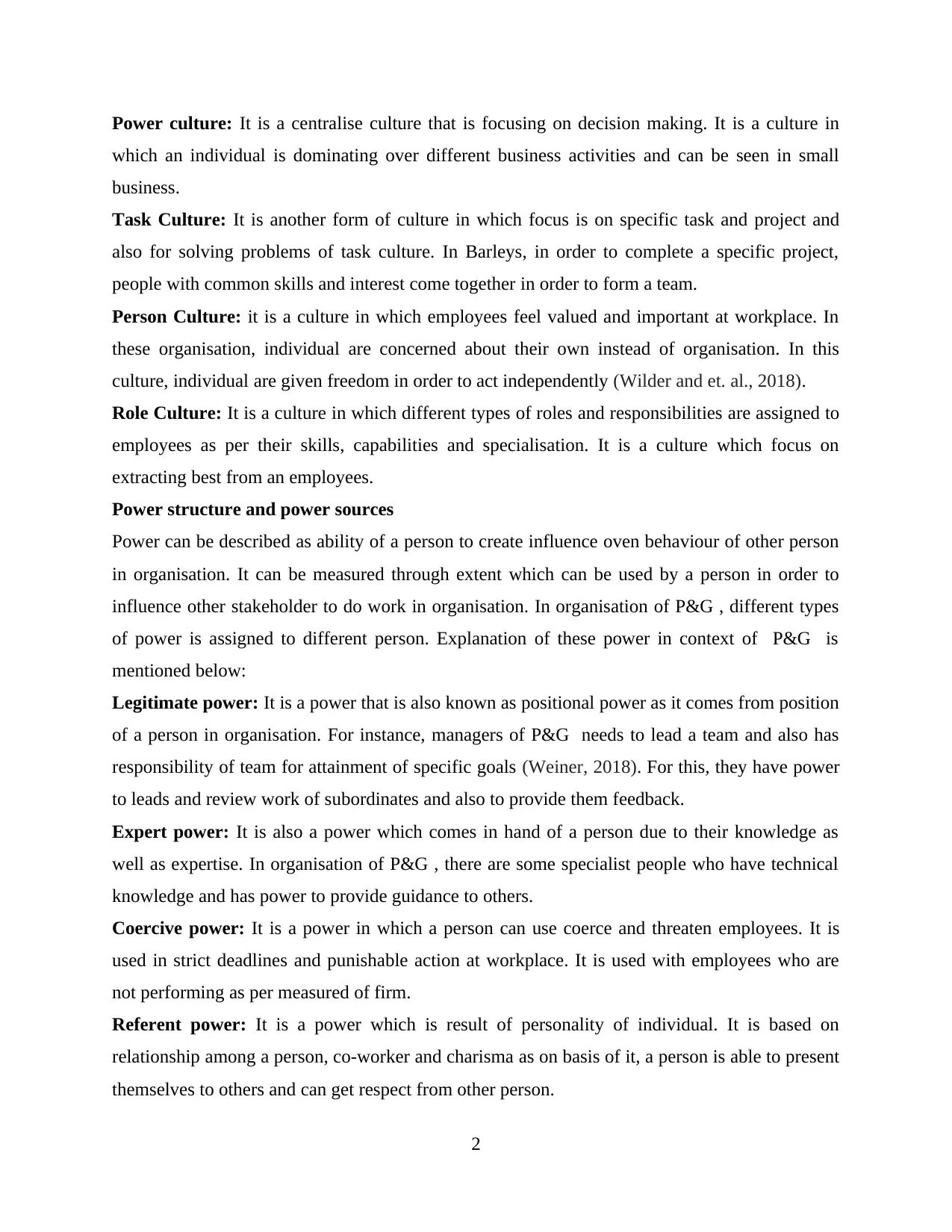
Power culture: It is a centralise culture that is focusing on decision making. It is a culture in
which an individual is dominating over different business activities and can be seen in small
business.
Task Culture: It is another form of culture in which focus is on specific task and project and
also for solving problems of task culture. In Barleys, in order to complete a specific project,
people with common skills and interest come together in order to form a team.
Person Culture: it is a culture in which employees feel valued and important at workplace. In
these organisation, individual are concerned about their own instead of organisation. In this
culture, individual are given freedom in order to act independently (Wilder and et. al., 2018).
Role Culture: It is a culture in which different types of roles and responsibilities are assigned to
employees as per their skills, capabilities and specialisation. It is a culture which focus on
extracting best from an employees.
Power structure and power sources
Power can be described as ability of a person to create influence oven behaviour of other person
in organisation. It can be measured through extent which can be used by a person in order to
influence other stakeholder to do work in organisation. In organisation of P&G , different types
of power is assigned to different person. Explanation of these power in context of P&G is
mentioned below:
Legitimate power: It is a power that is also known as positional power as it comes from position
of a person in organisation. For instance, managers of P&G needs to lead a team and also has
responsibility of team for attainment of specific goals (Weiner, 2018). For this, they have power
to leads and review work of subordinates and also to provide them feedback.
Expert power: It is also a power which comes in hand of a person due to their knowledge as
well as expertise. In organisation of P&G , there are some specialist people who have technical
knowledge and has power to provide guidance to others.
Coercive power: It is a power in which a person can use coerce and threaten employees. It is
used in strict deadlines and punishable action at workplace. It is used with employees who are
not performing as per measured of firm.
Referent power: It is a power which is result of personality of individual. It is based on
relationship among a person, co-worker and charisma as on basis of it, a person is able to present
themselves to others and can get respect from other person.
2
which an individual is dominating over different business activities and can be seen in small
business.
Task Culture: It is another form of culture in which focus is on specific task and project and
also for solving problems of task culture. In Barleys, in order to complete a specific project,
people with common skills and interest come together in order to form a team.
Person Culture: it is a culture in which employees feel valued and important at workplace. In
these organisation, individual are concerned about their own instead of organisation. In this
culture, individual are given freedom in order to act independently (Wilder and et. al., 2018).
Role Culture: It is a culture in which different types of roles and responsibilities are assigned to
employees as per their skills, capabilities and specialisation. It is a culture which focus on
extracting best from an employees.
Power structure and power sources
Power can be described as ability of a person to create influence oven behaviour of other person
in organisation. It can be measured through extent which can be used by a person in order to
influence other stakeholder to do work in organisation. In organisation of P&G , different types
of power is assigned to different person. Explanation of these power in context of P&G is
mentioned below:
Legitimate power: It is a power that is also known as positional power as it comes from position
of a person in organisation. For instance, managers of P&G needs to lead a team and also has
responsibility of team for attainment of specific goals (Weiner, 2018). For this, they have power
to leads and review work of subordinates and also to provide them feedback.
Expert power: It is also a power which comes in hand of a person due to their knowledge as
well as expertise. In organisation of P&G , there are some specialist people who have technical
knowledge and has power to provide guidance to others.
Coercive power: It is a power in which a person can use coerce and threaten employees. It is
used in strict deadlines and punishable action at workplace. It is used with employees who are
not performing as per measured of firm.
Referent power: It is a power which is result of personality of individual. It is based on
relationship among a person, co-worker and charisma as on basis of it, a person is able to present
themselves to others and can get respect from other person.
2
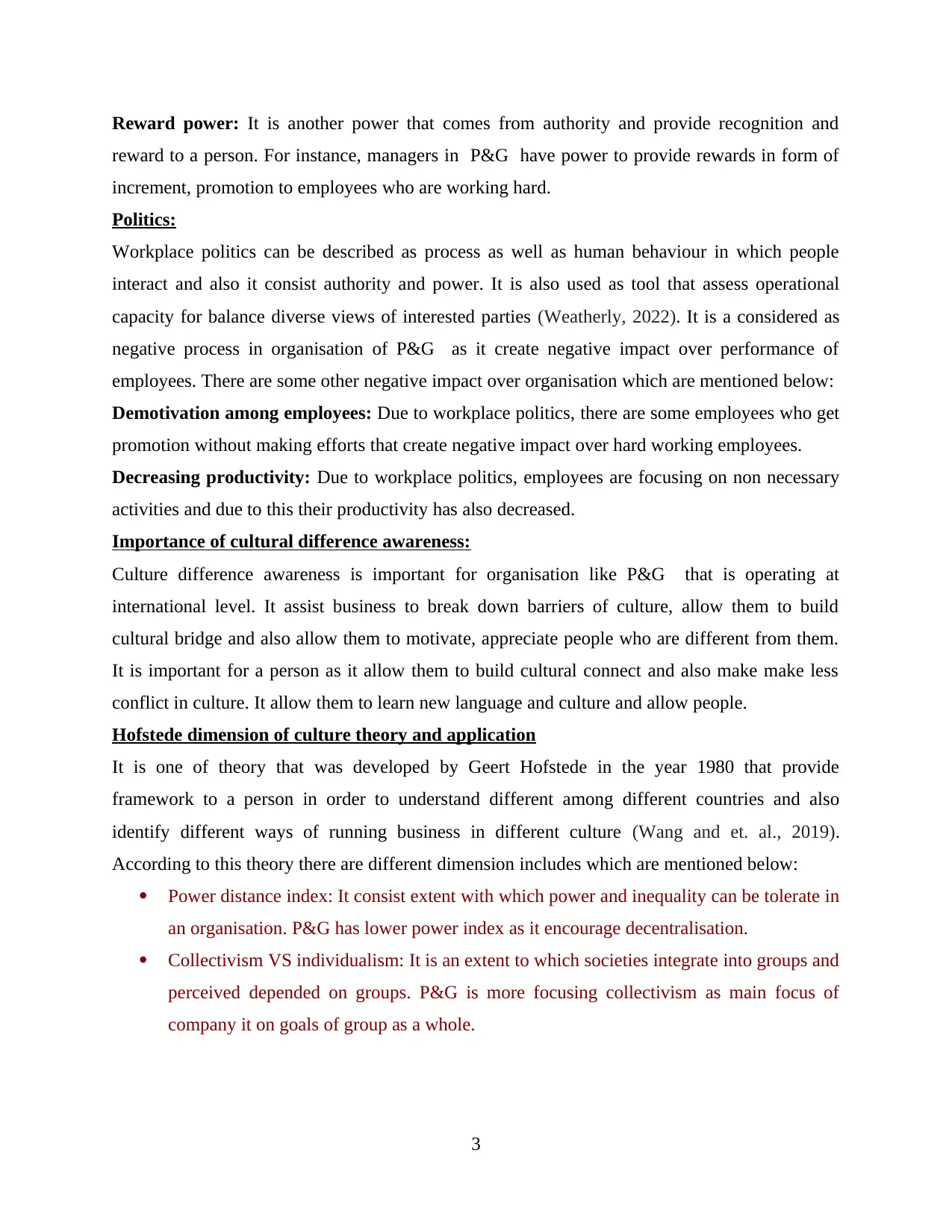
Reward power: It is another power that comes from authority and provide recognition and
reward to a person. For instance, managers in P&G have power to provide rewards in form of
increment, promotion to employees who are working hard.
Politics:
Workplace politics can be described as process as well as human behaviour in which people
interact and also it consist authority and power. It is also used as tool that assess operational
capacity for balance diverse views of interested parties (Weatherly, 2022). It is a considered as
negative process in organisation of P&G as it create negative impact over performance of
employees. There are some other negative impact over organisation which are mentioned below:
Demotivation among employees: Due to workplace politics, there are some employees who get
promotion without making efforts that create negative impact over hard working employees.
Decreasing productivity: Due to workplace politics, employees are focusing on non necessary
activities and due to this their productivity has also decreased.
Importance of cultural difference awareness:
Culture difference awareness is important for organisation like P&G that is operating at
international level. It assist business to break down barriers of culture, allow them to build
cultural bridge and also allow them to motivate, appreciate people who are different from them.
It is important for a person as it allow them to build cultural connect and also make make less
conflict in culture. It allow them to learn new language and culture and allow people.
Hofstede dimension of culture theory and application
It is one of theory that was developed by Geert Hofstede in the year 1980 that provide
framework to a person in order to understand different among different countries and also
identify different ways of running business in different culture (Wang and et. al., 2019).
According to this theory there are different dimension includes which are mentioned below:
Power distance index: It consist extent with which power and inequality can be tolerate in
an organisation. P&G has lower power index as it encourage decentralisation.
Collectivism VS individualism: It is an extent to which societies integrate into groups and
perceived depended on groups. P&G is more focusing collectivism as main focus of
company it on goals of group as a whole.
3
reward to a person. For instance, managers in P&G have power to provide rewards in form of
increment, promotion to employees who are working hard.
Politics:
Workplace politics can be described as process as well as human behaviour in which people
interact and also it consist authority and power. It is also used as tool that assess operational
capacity for balance diverse views of interested parties (Weatherly, 2022). It is a considered as
negative process in organisation of P&G as it create negative impact over performance of
employees. There are some other negative impact over organisation which are mentioned below:
Demotivation among employees: Due to workplace politics, there are some employees who get
promotion without making efforts that create negative impact over hard working employees.
Decreasing productivity: Due to workplace politics, employees are focusing on non necessary
activities and due to this their productivity has also decreased.
Importance of cultural difference awareness:
Culture difference awareness is important for organisation like P&G that is operating at
international level. It assist business to break down barriers of culture, allow them to build
cultural bridge and also allow them to motivate, appreciate people who are different from them.
It is important for a person as it allow them to build cultural connect and also make make less
conflict in culture. It allow them to learn new language and culture and allow people.
Hofstede dimension of culture theory and application
It is one of theory that was developed by Geert Hofstede in the year 1980 that provide
framework to a person in order to understand different among different countries and also
identify different ways of running business in different culture (Wang and et. al., 2019).
According to this theory there are different dimension includes which are mentioned below:
Power distance index: It consist extent with which power and inequality can be tolerate in
an organisation. P&G has lower power index as it encourage decentralisation.
Collectivism VS individualism: It is an extent to which societies integrate into groups and
perceived depended on groups. P&G is more focusing collectivism as main focus of
company it on goals of group as a whole.
3
⊘ This is a preview!⊘
Do you want full access?
Subscribe today to unlock all pages.

Trusted by 1+ million students worldwide
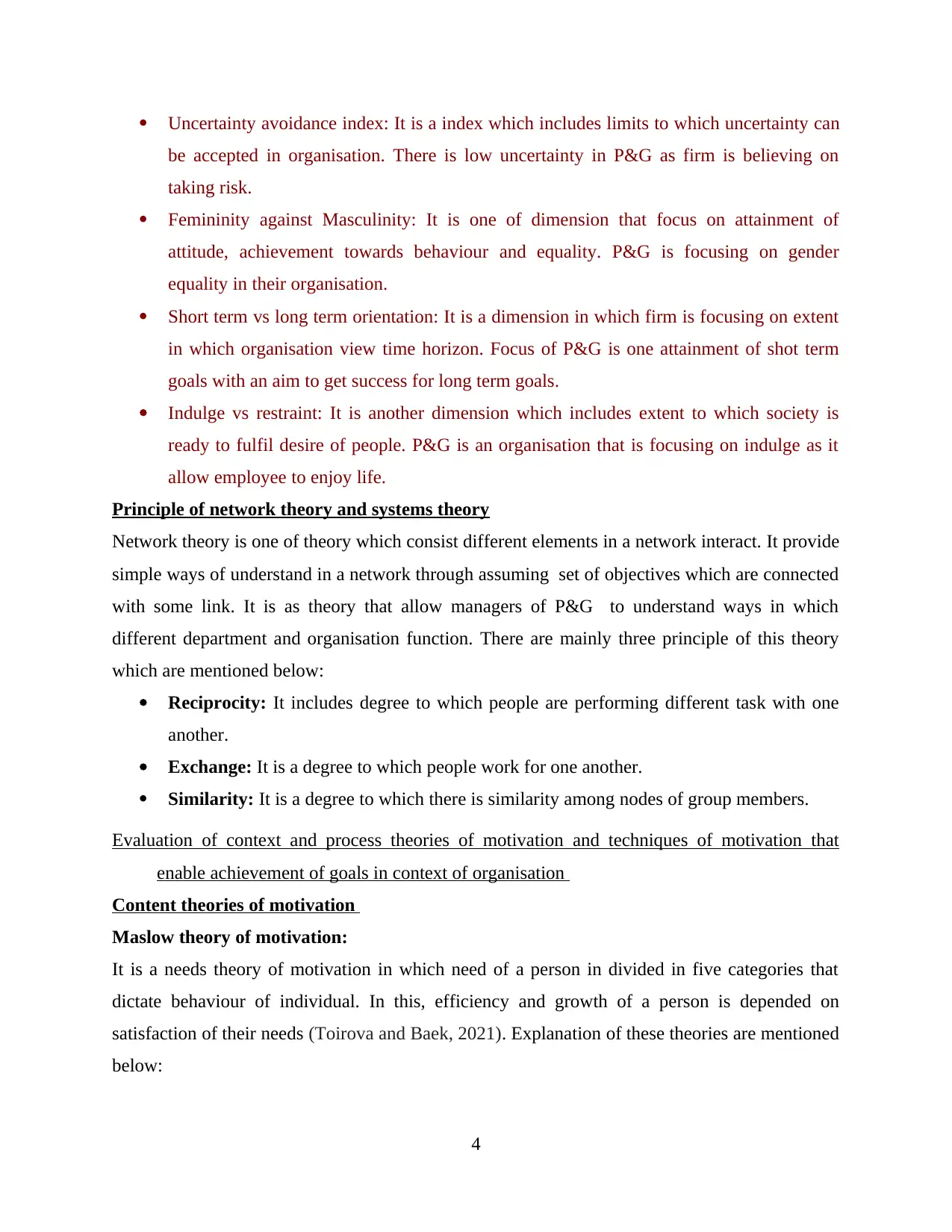
Uncertainty avoidance index: It is a index which includes limits to which uncertainty can
be accepted in organisation. There is low uncertainty in P&G as firm is believing on
taking risk.
Femininity against Masculinity: It is one of dimension that focus on attainment of
attitude, achievement towards behaviour and equality. P&G is focusing on gender
equality in their organisation.
Short term vs long term orientation: It is a dimension in which firm is focusing on extent
in which organisation view time horizon. Focus of P&G is one attainment of shot term
goals with an aim to get success for long term goals.
Indulge vs restraint: It is another dimension which includes extent to which society is
ready to fulfil desire of people. P&G is an organisation that is focusing on indulge as it
allow employee to enjoy life.
Principle of network theory and systems theory
Network theory is one of theory which consist different elements in a network interact. It provide
simple ways of understand in a network through assuming set of objectives which are connected
with some link. It is as theory that allow managers of P&G to understand ways in which
different department and organisation function. There are mainly three principle of this theory
which are mentioned below:
Reciprocity: It includes degree to which people are performing different task with one
another.
Exchange: It is a degree to which people work for one another.
Similarity: It is a degree to which there is similarity among nodes of group members.
Evaluation of context and process theories of motivation and techniques of motivation that
enable achievement of goals in context of organisation
Content theories of motivation
Maslow theory of motivation:
It is a needs theory of motivation in which need of a person in divided in five categories that
dictate behaviour of individual. In this, efficiency and growth of a person is depended on
satisfaction of their needs (Toirova and Baek, 2021). Explanation of these theories are mentioned
below:
4
be accepted in organisation. There is low uncertainty in P&G as firm is believing on
taking risk.
Femininity against Masculinity: It is one of dimension that focus on attainment of
attitude, achievement towards behaviour and equality. P&G is focusing on gender
equality in their organisation.
Short term vs long term orientation: It is a dimension in which firm is focusing on extent
in which organisation view time horizon. Focus of P&G is one attainment of shot term
goals with an aim to get success for long term goals.
Indulge vs restraint: It is another dimension which includes extent to which society is
ready to fulfil desire of people. P&G is an organisation that is focusing on indulge as it
allow employee to enjoy life.
Principle of network theory and systems theory
Network theory is one of theory which consist different elements in a network interact. It provide
simple ways of understand in a network through assuming set of objectives which are connected
with some link. It is as theory that allow managers of P&G to understand ways in which
different department and organisation function. There are mainly three principle of this theory
which are mentioned below:
Reciprocity: It includes degree to which people are performing different task with one
another.
Exchange: It is a degree to which people work for one another.
Similarity: It is a degree to which there is similarity among nodes of group members.
Evaluation of context and process theories of motivation and techniques of motivation that
enable achievement of goals in context of organisation
Content theories of motivation
Maslow theory of motivation:
It is a needs theory of motivation in which need of a person in divided in five categories that
dictate behaviour of individual. In this, efficiency and growth of a person is depended on
satisfaction of their needs (Toirova and Baek, 2021). Explanation of these theories are mentioned
below:
4
Paraphrase This Document
Need a fresh take? Get an instant paraphrase of this document with our AI Paraphraser
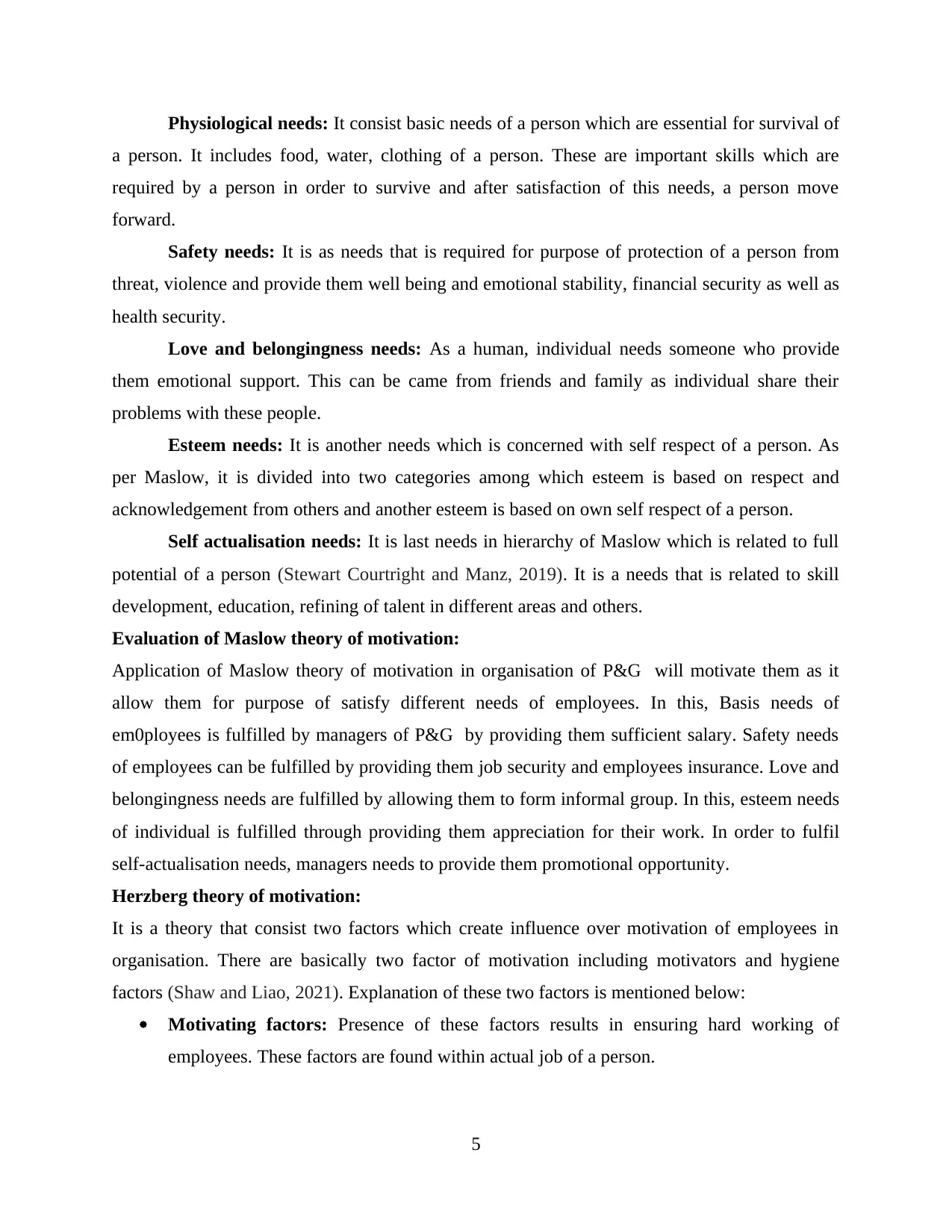
Physiological needs: It consist basic needs of a person which are essential for survival of
a person. It includes food, water, clothing of a person. These are important skills which are
required by a person in order to survive and after satisfaction of this needs, a person move
forward.
Safety needs: It is as needs that is required for purpose of protection of a person from
threat, violence and provide them well being and emotional stability, financial security as well as
health security.
Love and belongingness needs: As a human, individual needs someone who provide
them emotional support. This can be came from friends and family as individual share their
problems with these people.
Esteem needs: It is another needs which is concerned with self respect of a person. As
per Maslow, it is divided into two categories among which esteem is based on respect and
acknowledgement from others and another esteem is based on own self respect of a person.
Self actualisation needs: It is last needs in hierarchy of Maslow which is related to full
potential of a person (Stewart Courtright and Manz, 2019). It is a needs that is related to skill
development, education, refining of talent in different areas and others.
Evaluation of Maslow theory of motivation:
Application of Maslow theory of motivation in organisation of P&G will motivate them as it
allow them for purpose of satisfy different needs of employees. In this, Basis needs of
em0ployees is fulfilled by managers of P&G by providing them sufficient salary. Safety needs
of employees can be fulfilled by providing them job security and employees insurance. Love and
belongingness needs are fulfilled by allowing them to form informal group. In this, esteem needs
of individual is fulfilled through providing them appreciation for their work. In order to fulfil
self-actualisation needs, managers needs to provide them promotional opportunity.
Herzberg theory of motivation:
It is a theory that consist two factors which create influence over motivation of employees in
organisation. There are basically two factor of motivation including motivators and hygiene
factors (Shaw and Liao, 2021). Explanation of these two factors is mentioned below:
Motivating factors: Presence of these factors results in ensuring hard working of
employees. These factors are found within actual job of a person.
5
a person. It includes food, water, clothing of a person. These are important skills which are
required by a person in order to survive and after satisfaction of this needs, a person move
forward.
Safety needs: It is as needs that is required for purpose of protection of a person from
threat, violence and provide them well being and emotional stability, financial security as well as
health security.
Love and belongingness needs: As a human, individual needs someone who provide
them emotional support. This can be came from friends and family as individual share their
problems with these people.
Esteem needs: It is another needs which is concerned with self respect of a person. As
per Maslow, it is divided into two categories among which esteem is based on respect and
acknowledgement from others and another esteem is based on own self respect of a person.
Self actualisation needs: It is last needs in hierarchy of Maslow which is related to full
potential of a person (Stewart Courtright and Manz, 2019). It is a needs that is related to skill
development, education, refining of talent in different areas and others.
Evaluation of Maslow theory of motivation:
Application of Maslow theory of motivation in organisation of P&G will motivate them as it
allow them for purpose of satisfy different needs of employees. In this, Basis needs of
em0ployees is fulfilled by managers of P&G by providing them sufficient salary. Safety needs
of employees can be fulfilled by providing them job security and employees insurance. Love and
belongingness needs are fulfilled by allowing them to form informal group. In this, esteem needs
of individual is fulfilled through providing them appreciation for their work. In order to fulfil
self-actualisation needs, managers needs to provide them promotional opportunity.
Herzberg theory of motivation:
It is a theory that consist two factors which create influence over motivation of employees in
organisation. There are basically two factor of motivation including motivators and hygiene
factors (Shaw and Liao, 2021). Explanation of these two factors is mentioned below:
Motivating factors: Presence of these factors results in ensuring hard working of
employees. These factors are found within actual job of a person.
5
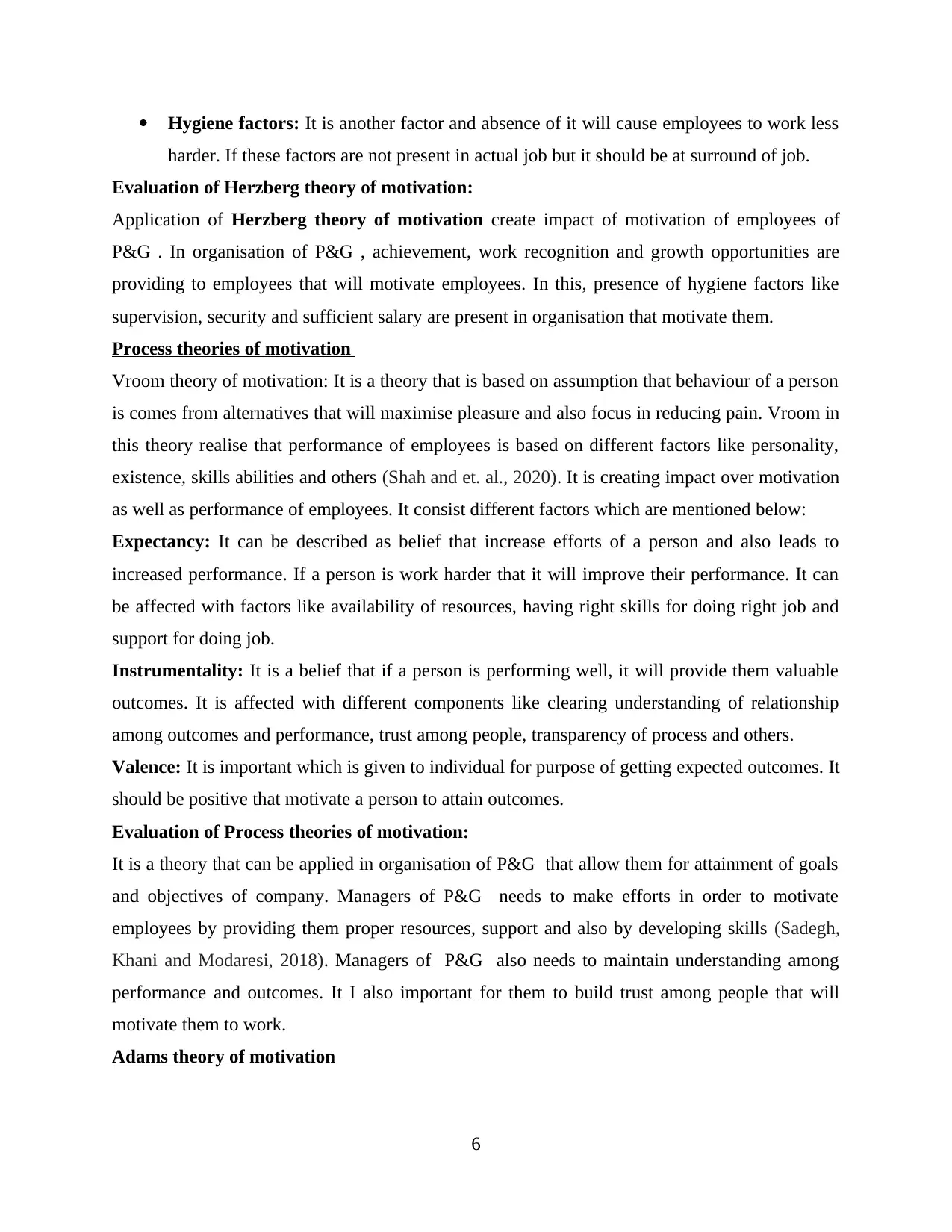
Hygiene factors: It is another factor and absence of it will cause employees to work less
harder. If these factors are not present in actual job but it should be at surround of job.
Evaluation of Herzberg theory of motivation:
Application of Herzberg theory of motivation create impact of motivation of employees of
P&G . In organisation of P&G , achievement, work recognition and growth opportunities are
providing to employees that will motivate employees. In this, presence of hygiene factors like
supervision, security and sufficient salary are present in organisation that motivate them.
Process theories of motivation
Vroom theory of motivation: It is a theory that is based on assumption that behaviour of a person
is comes from alternatives that will maximise pleasure and also focus in reducing pain. Vroom in
this theory realise that performance of employees is based on different factors like personality,
existence, skills abilities and others (Shah and et. al., 2020). It is creating impact over motivation
as well as performance of employees. It consist different factors which are mentioned below:
Expectancy: It can be described as belief that increase efforts of a person and also leads to
increased performance. If a person is work harder that it will improve their performance. It can
be affected with factors like availability of resources, having right skills for doing right job and
support for doing job.
Instrumentality: It is a belief that if a person is performing well, it will provide them valuable
outcomes. It is affected with different components like clearing understanding of relationship
among outcomes and performance, trust among people, transparency of process and others.
Valence: It is important which is given to individual for purpose of getting expected outcomes. It
should be positive that motivate a person to attain outcomes.
Evaluation of Process theories of motivation:
It is a theory that can be applied in organisation of P&G that allow them for attainment of goals
and objectives of company. Managers of P&G needs to make efforts in order to motivate
employees by providing them proper resources, support and also by developing skills (Sadegh,
Khani and Modaresi, 2018). Managers of P&G also needs to maintain understanding among
performance and outcomes. It I also important for them to build trust among people that will
motivate them to work.
Adams theory of motivation
6
harder. If these factors are not present in actual job but it should be at surround of job.
Evaluation of Herzberg theory of motivation:
Application of Herzberg theory of motivation create impact of motivation of employees of
P&G . In organisation of P&G , achievement, work recognition and growth opportunities are
providing to employees that will motivate employees. In this, presence of hygiene factors like
supervision, security and sufficient salary are present in organisation that motivate them.
Process theories of motivation
Vroom theory of motivation: It is a theory that is based on assumption that behaviour of a person
is comes from alternatives that will maximise pleasure and also focus in reducing pain. Vroom in
this theory realise that performance of employees is based on different factors like personality,
existence, skills abilities and others (Shah and et. al., 2020). It is creating impact over motivation
as well as performance of employees. It consist different factors which are mentioned below:
Expectancy: It can be described as belief that increase efforts of a person and also leads to
increased performance. If a person is work harder that it will improve their performance. It can
be affected with factors like availability of resources, having right skills for doing right job and
support for doing job.
Instrumentality: It is a belief that if a person is performing well, it will provide them valuable
outcomes. It is affected with different components like clearing understanding of relationship
among outcomes and performance, trust among people, transparency of process and others.
Valence: It is important which is given to individual for purpose of getting expected outcomes. It
should be positive that motivate a person to attain outcomes.
Evaluation of Process theories of motivation:
It is a theory that can be applied in organisation of P&G that allow them for attainment of goals
and objectives of company. Managers of P&G needs to make efforts in order to motivate
employees by providing them proper resources, support and also by developing skills (Sadegh,
Khani and Modaresi, 2018). Managers of P&G also needs to maintain understanding among
performance and outcomes. It I also important for them to build trust among people that will
motivate them to work.
Adams theory of motivation
6
⊘ This is a preview!⊘
Do you want full access?
Subscribe today to unlock all pages.

Trusted by 1+ million students worldwide
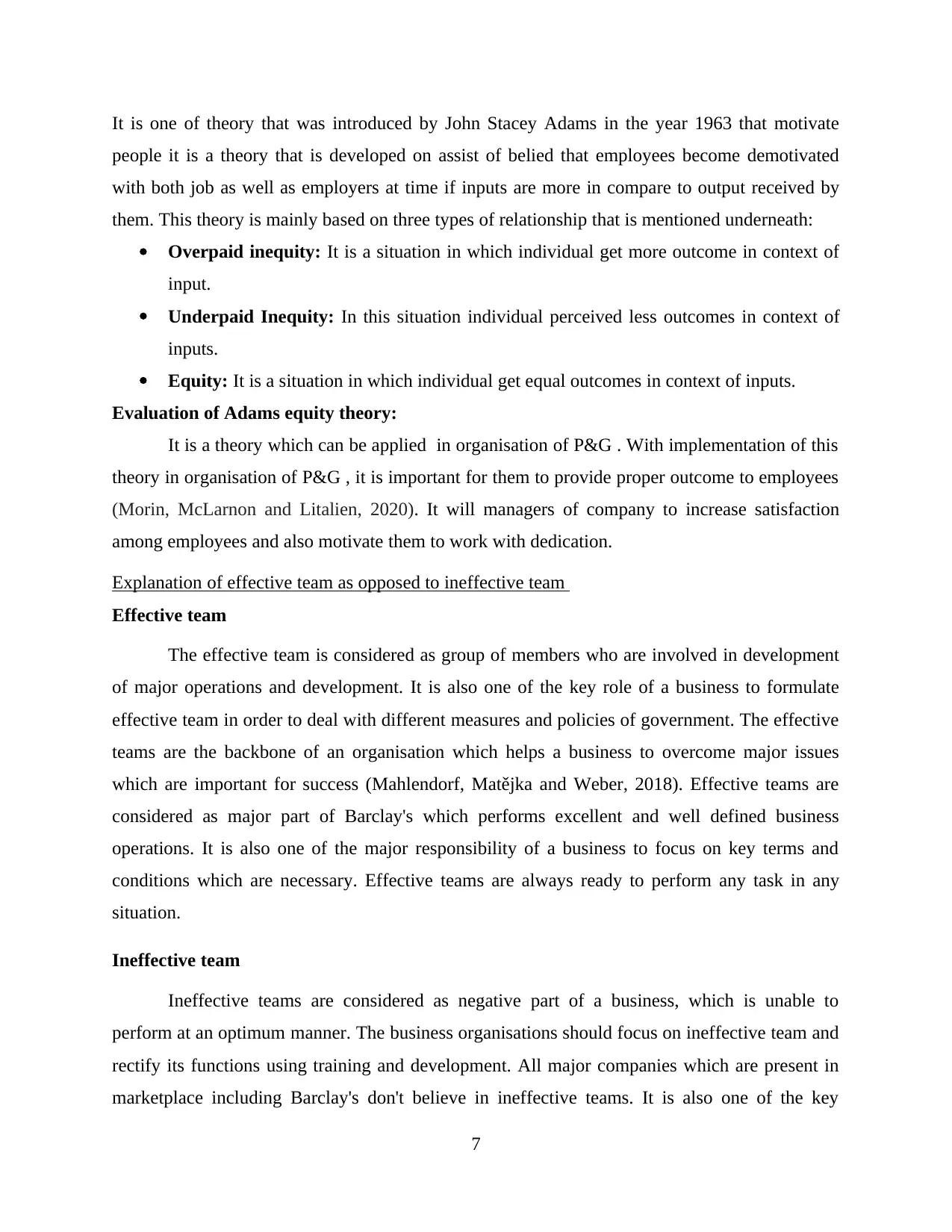
It is one of theory that was introduced by John Stacey Adams in the year 1963 that motivate
people it is a theory that is developed on assist of belied that employees become demotivated
with both job as well as employers at time if inputs are more in compare to output received by
them. This theory is mainly based on three types of relationship that is mentioned underneath:
Overpaid inequity: It is a situation in which individual get more outcome in context of
input.
Underpaid Inequity: In this situation individual perceived less outcomes in context of
inputs.
Equity: It is a situation in which individual get equal outcomes in context of inputs.
Evaluation of Adams equity theory:
It is a theory which can be applied in organisation of P&G . With implementation of this
theory in organisation of P&G , it is important for them to provide proper outcome to employees
(Morin, McLarnon and Litalien, 2020). It will managers of company to increase satisfaction
among employees and also motivate them to work with dedication.
Explanation of effective team as opposed to ineffective team
Effective team
The effective team is considered as group of members who are involved in development
of major operations and development. It is also one of the key role of a business to formulate
effective team in order to deal with different measures and policies of government. The effective
teams are the backbone of an organisation which helps a business to overcome major issues
which are important for success (Mahlendorf, Matějka and Weber, 2018). Effective teams are
considered as major part of Barclay's which performs excellent and well defined business
operations. It is also one of the major responsibility of a business to focus on key terms and
conditions which are necessary. Effective teams are always ready to perform any task in any
situation.
Ineffective team
Ineffective teams are considered as negative part of a business, which is unable to
perform at an optimum manner. The business organisations should focus on ineffective team and
rectify its functions using training and development. All major companies which are present in
marketplace including Barclay's don't believe in ineffective teams. It is also one of the key
7
people it is a theory that is developed on assist of belied that employees become demotivated
with both job as well as employers at time if inputs are more in compare to output received by
them. This theory is mainly based on three types of relationship that is mentioned underneath:
Overpaid inequity: It is a situation in which individual get more outcome in context of
input.
Underpaid Inequity: In this situation individual perceived less outcomes in context of
inputs.
Equity: It is a situation in which individual get equal outcomes in context of inputs.
Evaluation of Adams equity theory:
It is a theory which can be applied in organisation of P&G . With implementation of this
theory in organisation of P&G , it is important for them to provide proper outcome to employees
(Morin, McLarnon and Litalien, 2020). It will managers of company to increase satisfaction
among employees and also motivate them to work with dedication.
Explanation of effective team as opposed to ineffective team
Effective team
The effective team is considered as group of members who are involved in development
of major operations and development. It is also one of the key role of a business to formulate
effective team in order to deal with different measures and policies of government. The effective
teams are the backbone of an organisation which helps a business to overcome major issues
which are important for success (Mahlendorf, Matějka and Weber, 2018). Effective teams are
considered as major part of Barclay's which performs excellent and well defined business
operations. It is also one of the major responsibility of a business to focus on key terms and
conditions which are necessary. Effective teams are always ready to perform any task in any
situation.
Ineffective team
Ineffective teams are considered as negative part of a business, which is unable to
perform at an optimum manner. The business organisations should focus on ineffective team and
rectify its functions using training and development. All major companies which are present in
marketplace including Barclay's don't believe in ineffective teams. It is also one of the key
7
Paraphrase This Document
Need a fresh take? Get an instant paraphrase of this document with our AI Paraphraser
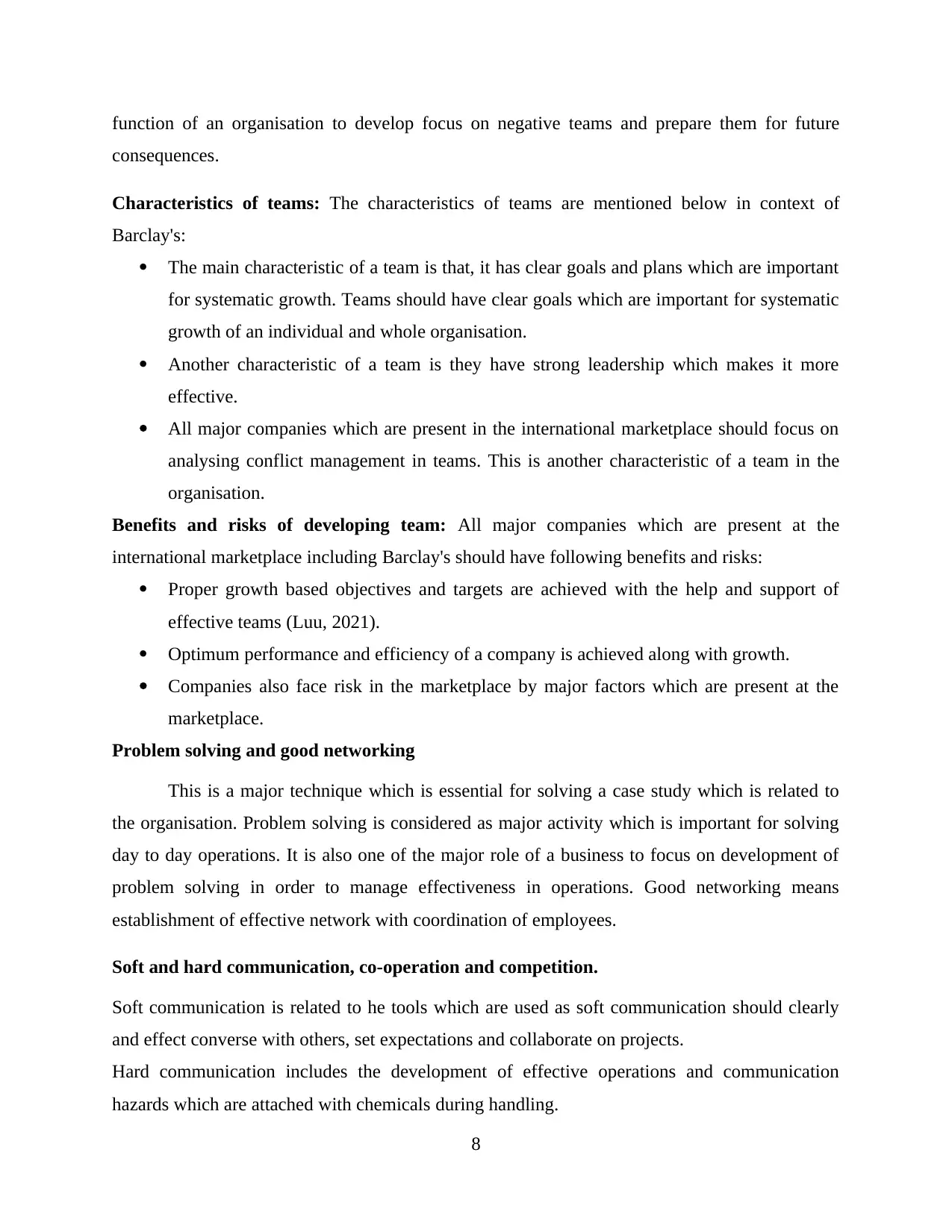
function of an organisation to develop focus on negative teams and prepare them for future
consequences.
Characteristics of teams: The characteristics of teams are mentioned below in context of
Barclay's:
The main characteristic of a team is that, it has clear goals and plans which are important
for systematic growth. Teams should have clear goals which are important for systematic
growth of an individual and whole organisation.
Another characteristic of a team is they have strong leadership which makes it more
effective.
All major companies which are present in the international marketplace should focus on
analysing conflict management in teams. This is another characteristic of a team in the
organisation.
Benefits and risks of developing team: All major companies which are present at the
international marketplace including Barclay's should have following benefits and risks:
Proper growth based objectives and targets are achieved with the help and support of
effective teams (Luu, 2021).
Optimum performance and efficiency of a company is achieved along with growth.
Companies also face risk in the marketplace by major factors which are present at the
marketplace.
Problem solving and good networking
This is a major technique which is essential for solving a case study which is related to
the organisation. Problem solving is considered as major activity which is important for solving
day to day operations. It is also one of the major role of a business to focus on development of
problem solving in order to manage effectiveness in operations. Good networking means
establishment of effective network with coordination of employees.
Soft and hard communication, co-operation and competition.
Soft communication is related to he tools which are used as soft communication should clearly
and effect converse with others, set expectations and collaborate on projects.
Hard communication includes the development of effective operations and communication
hazards which are attached with chemicals during handling.
8
consequences.
Characteristics of teams: The characteristics of teams are mentioned below in context of
Barclay's:
The main characteristic of a team is that, it has clear goals and plans which are important
for systematic growth. Teams should have clear goals which are important for systematic
growth of an individual and whole organisation.
Another characteristic of a team is they have strong leadership which makes it more
effective.
All major companies which are present in the international marketplace should focus on
analysing conflict management in teams. This is another characteristic of a team in the
organisation.
Benefits and risks of developing team: All major companies which are present at the
international marketplace including Barclay's should have following benefits and risks:
Proper growth based objectives and targets are achieved with the help and support of
effective teams (Luu, 2021).
Optimum performance and efficiency of a company is achieved along with growth.
Companies also face risk in the marketplace by major factors which are present at the
marketplace.
Problem solving and good networking
This is a major technique which is essential for solving a case study which is related to
the organisation. Problem solving is considered as major activity which is important for solving
day to day operations. It is also one of the major role of a business to focus on development of
problem solving in order to manage effectiveness in operations. Good networking means
establishment of effective network with coordination of employees.
Soft and hard communication, co-operation and competition.
Soft communication is related to he tools which are used as soft communication should clearly
and effect converse with others, set expectations and collaborate on projects.
Hard communication includes the development of effective operations and communication
hazards which are attached with chemicals during handling.
8
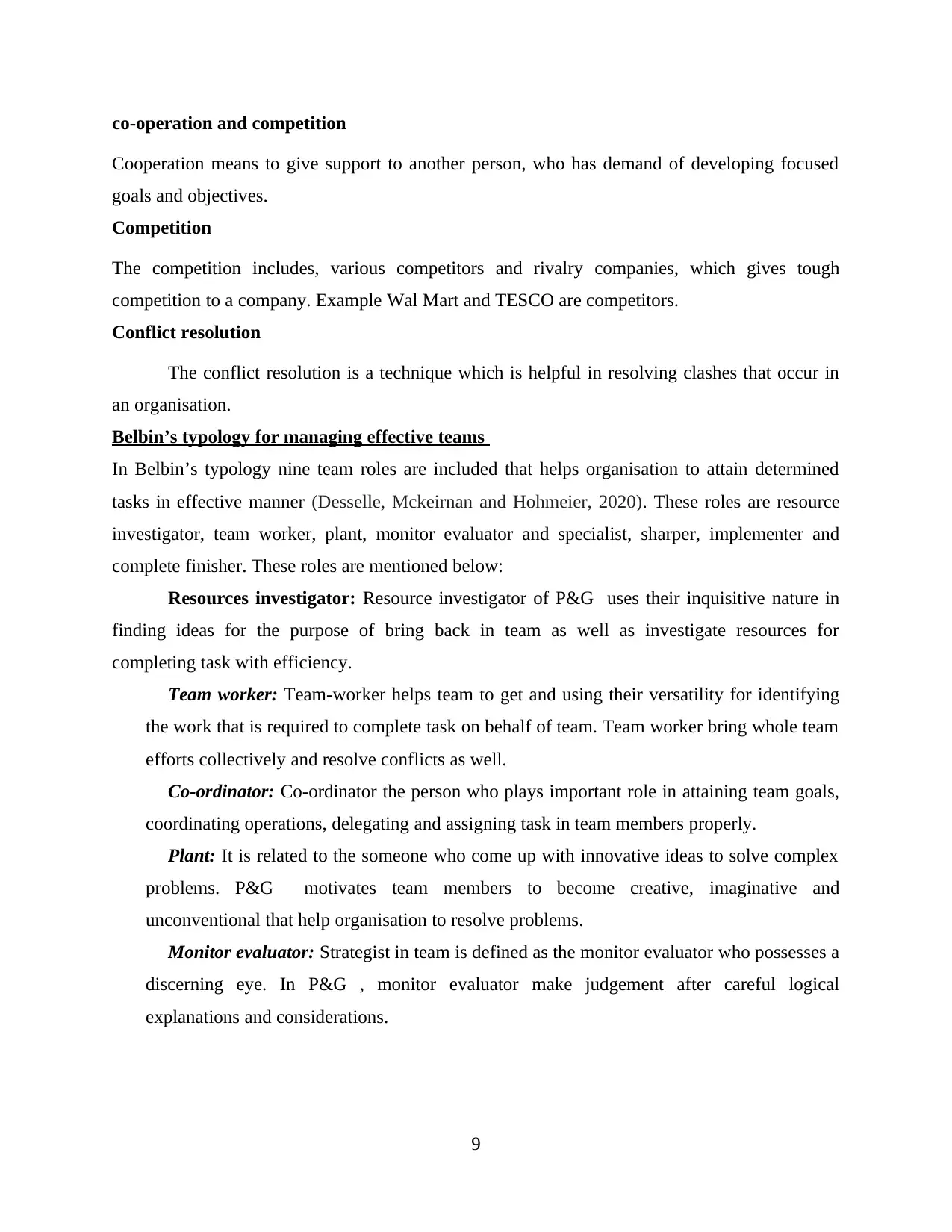
co-operation and competition
Cooperation means to give support to another person, who has demand of developing focused
goals and objectives.
Competition
The competition includes, various competitors and rivalry companies, which gives tough
competition to a company. Example Wal Mart and TESCO are competitors.
Conflict resolution
The conflict resolution is a technique which is helpful in resolving clashes that occur in
an organisation.
Belbin’s typology for managing effective teams
In Belbin’s typology nine team roles are included that helps organisation to attain determined
tasks in effective manner (Desselle, Mckeirnan and Hohmeier, 2020). These roles are resource
investigator, team worker, plant, monitor evaluator and specialist, sharper, implementer and
complete finisher. These roles are mentioned below:
Resources investigator: Resource investigator of P&G uses their inquisitive nature in
finding ideas for the purpose of bring back in team as well as investigate resources for
completing task with efficiency.
Team worker: Team-worker helps team to get and using their versatility for identifying
the work that is required to complete task on behalf of team. Team worker bring whole team
efforts collectively and resolve conflicts as well.
Co-ordinator: Co-ordinator the person who plays important role in attaining team goals,
coordinating operations, delegating and assigning task in team members properly.
Plant: It is related to the someone who come up with innovative ideas to solve complex
problems. P&G motivates team members to become creative, imaginative and
unconventional that help organisation to resolve problems.
Monitor evaluator: Strategist in team is defined as the monitor evaluator who possesses a
discerning eye. In P&G , monitor evaluator make judgement after careful logical
explanations and considerations.
9
Cooperation means to give support to another person, who has demand of developing focused
goals and objectives.
Competition
The competition includes, various competitors and rivalry companies, which gives tough
competition to a company. Example Wal Mart and TESCO are competitors.
Conflict resolution
The conflict resolution is a technique which is helpful in resolving clashes that occur in
an organisation.
Belbin’s typology for managing effective teams
In Belbin’s typology nine team roles are included that helps organisation to attain determined
tasks in effective manner (Desselle, Mckeirnan and Hohmeier, 2020). These roles are resource
investigator, team worker, plant, monitor evaluator and specialist, sharper, implementer and
complete finisher. These roles are mentioned below:
Resources investigator: Resource investigator of P&G uses their inquisitive nature in
finding ideas for the purpose of bring back in team as well as investigate resources for
completing task with efficiency.
Team worker: Team-worker helps team to get and using their versatility for identifying
the work that is required to complete task on behalf of team. Team worker bring whole team
efforts collectively and resolve conflicts as well.
Co-ordinator: Co-ordinator the person who plays important role in attaining team goals,
coordinating operations, delegating and assigning task in team members properly.
Plant: It is related to the someone who come up with innovative ideas to solve complex
problems. P&G motivates team members to become creative, imaginative and
unconventional that help organisation to resolve problems.
Monitor evaluator: Strategist in team is defined as the monitor evaluator who possesses a
discerning eye. In P&G , monitor evaluator make judgement after careful logical
explanations and considerations.
9
⊘ This is a preview!⊘
Do you want full access?
Subscribe today to unlock all pages.

Trusted by 1+ million students worldwide
1 out of 17
Related Documents
Your All-in-One AI-Powered Toolkit for Academic Success.
+13062052269
info@desklib.com
Available 24*7 on WhatsApp / Email
![[object Object]](/_next/static/media/star-bottom.7253800d.svg)
Unlock your academic potential
Copyright © 2020–2025 A2Z Services. All Rights Reserved. Developed and managed by ZUCOL.





